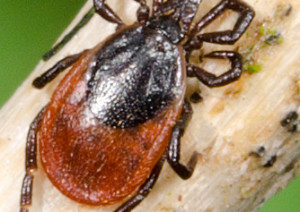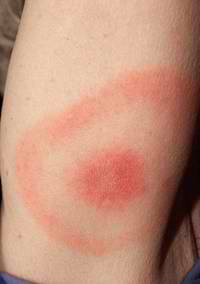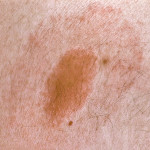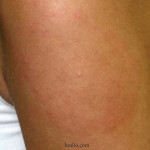Not all ticks carry infections. Many areas of the US don’t have a serious tick problem.  Unfortunately, Central MA is not one of them.
Unfortunately, Central MA is not one of them.
Ticks can carry more than one infection, which are often associated with the tick species. Our most common tick in Massachusetts is the Deer tick, a carrier of Lyme Disease.
When bitten by a Deer tick, it can take 3-30 days before any sign of a Lyme infection has occurred. It is important to write down on a calendar when you were bitten. Any sign or symptoms occurring within 30 days should be reported to your physician. He or she will need to know when you were bitten and when you noticed the first symptoms. Ticks use an anesthetic when they bite, so they often go unnoticed. If a tick is removed within 48 hours of first biting, the risk of them transmitting Lyme Disease is believed to be low.
Lyme disease prevention begins with trusted Central Mass tick control.
If you do find a tick attached to your skin, there are certain things you need to know. Along with fatigue, chills, fever, headache, muscle and joint pain and swollen lymph nodes you should look for physical signs of an infection as well. In the case of Lyme Disease, the infection will often show as a bulls-eye rash on your skin. It can appear around the bite or anywhere on the skin. The rash will often gradually expand further out from the area first discovered. Some patients will simply notice a red blotch with no bulls-eye. The rash is usually not itchy or painful. Thirty percent of infected patients will not see a rash at all, so noting the other symptoms you are experiencing is important in your diagnosis.
Also read: Should I put anything on a tick bite?
The bulls-eye rash can have other variations. Immune response, skin pigmentation and the location of the bite can affect how the rash develops. In the photo on the right, only a small, inflamed area appears around the bite. This inflammation is a first sign of a possible infection but not conclusive. Inflammation is a naturally occurring healing process our body uses to repair damaged cells. Consider any inflammation an indication you need to observe if you have any other symptoms and if a rash around the bite area.
 This photo is the classic bulls-eye rash with which we are most familiar. It clearly looks like a bulls-eye and is indicative of a Lyme infection.
This photo is the classic bulls-eye rash with which we are most familiar. It clearly looks like a bulls-eye and is indicative of a Lyme infection.

This photo shows a less defined bulls-eye. It does have a reddish or brown center area with a lighter brown area around it. This patient had a Lyme infection.

On tanned skin, the bulls-eye rash can be even more difficult to distinguish. The darker pigmentation of the skin makes the rash more subdued and difficult to distinguish. This photo is from a pediatric patient with a Lyme infection.
The most important thing to remember when bitten by a tick is to track your symptoms. In many cases, no rash may appear. Each patient’s immune system will respond differently to an infection but a rash is one more clue that a Lyme infection has occurred.
Remember, if you are in good health and Lyme Disease is diagnosed early you have an excellent prognosis of overcoming the disease after a few weeks of antibiotics. Contacting your doctor as soon as any symptoms appear is your best course of action in overcoming any worry and getting rid of the disease.
Also read: Is Chronic Lyme disease real?
